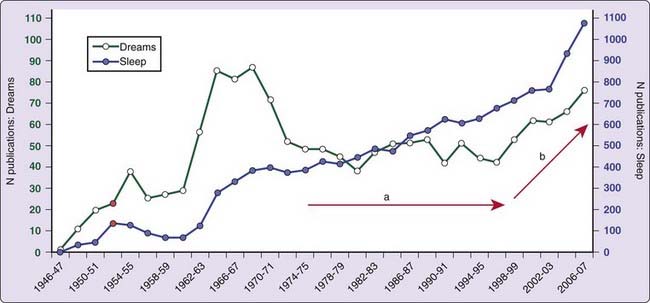Chapter 47 Introduction
The Changing Historical Context of Dream Research
Dream research is undergoing a period of vitality not seen since the 1960s, when the influence of Aserinsky and Kleitman’s1 discovery on the area reached a peak (see reference 2 for review). Figure 47-1 illustrates this trend using one key index of research health: the annual number of publications on the topic. The number of publications from 1946 to 2007 is plotted on separate frequency scales for Dreams and for Sleep (minus Dreams). For Dreams, the early increase in publications peaking in the 1960s is followed by a 25-year period of stagnation, then a steady rise beginning at the turn of the 21st century. For Sleep, a steady linear growth over time since the early 1960s is unmistakable.
It would be incorrect to assume that this recent growth trend in dream research reflects a resolution of methodological problems that have plagued the area for decades (see reference 3 for review). In large part, these problems remain. Rather, developments in the nature, function, and correlates of dreaming have spurred renewed activity among some researchers.
In the realm of basic research, new results from studies assessing brain activity during sleep by positron emission tomographic imaging and recordings of cellular neuromodulation are providing insights into the nature and function of dreaming (Chapter 48). Such studies reveal possible neurophysiologic explanations for common characteristics of dream consciousness, such as increased emotionality (in limbic structures) or lack of insight (in frontal structures). In the related field of chronobiology (Chapter 49), new findings and theoretical models are starting to lay bare the underlying timing mechanisms that control the ebb and flow of dream processes between sleep stages (ultradian rhythm) and across the sleep–wake cycle (circadian rhythm). At a basic phenomenological level, there is a convergence of renewed interest in reality simulation as an essential characteristic of dreaming, leading to a reconsideration of how content and bizarreness measures reflect simulation processes (Chapter 51). Similarly, basic research has made considerable gains in optimizing methods for analyzing dream content and in applying these to a variety of populations (Chapter 50). This research, too, indicates that dreams accurately simulate the objects and activities of waking life and are related to general waking life dimensions but not to day-to-day events. Two dynamic areas of contemporary research hold great promise for clarifying the essential functions of dreaming. On the one hand, a large and rapidly growing body of findings supports the notion that sleep subserves various functions of memory consolidation. Dreaming’s specific role in these memory functions is only beginning to emerge, but the existing research provides a solid basis for formulating new theories of dream involvement and guiding hypothesis testing (Chapter 55). In a related vein, many studies converge in supporting the notion that dreaming serves a cross-night affect regulation function (Chapter 54). Such studies dovetail with work demonstrating a specific role for rapid eye movement (REM) sleep in the consolidation of emotional memories.
In the realm of clinical research, renewed interest is indicated by several important developments. More attention is being paid to describing the characteristic alterations in dreaming that accompany sleep disorders, such as narcolepsy, insomnia, and sleep apnea (Chapter 52). Evidence now suggests that such alterations may improve diagnosis of sleep problems and provide insights into their pathophysiologic mechanisms. The changes in dreaming that occur as a function of stress and trauma, as in posttraumatic stress disorder, is a rapidly developing area (Chapter 53) and includes delineation of how dream content is modified by stress and how and why nightmares may “replay” stressful or traumatic events in nearly identical form over time. Equally important advances have occurred in research on nightmare disorder and REM sleep behavior disorder, although much of this research is discussed in chapters in the parasomnias section (see Chapters 97 and 98).
1 Aserinsky E, Kleitman N. Regularly occurring periods of eye motility, and concomitant phenomena, during sleep. Science. 1953;118:273-274.
2 Nielsen TA, Germain A. Publication patterns in dream research: trends in the medical and psychological literatures. Dreaming. 1998;8:47-58.
3 Stickgold R. The questions of dream research. Sleep Hypnosis. 2004;3:4-7.
Stay updated, free articles. Join our Telegram channel

Full access? Get Clinical Tree



